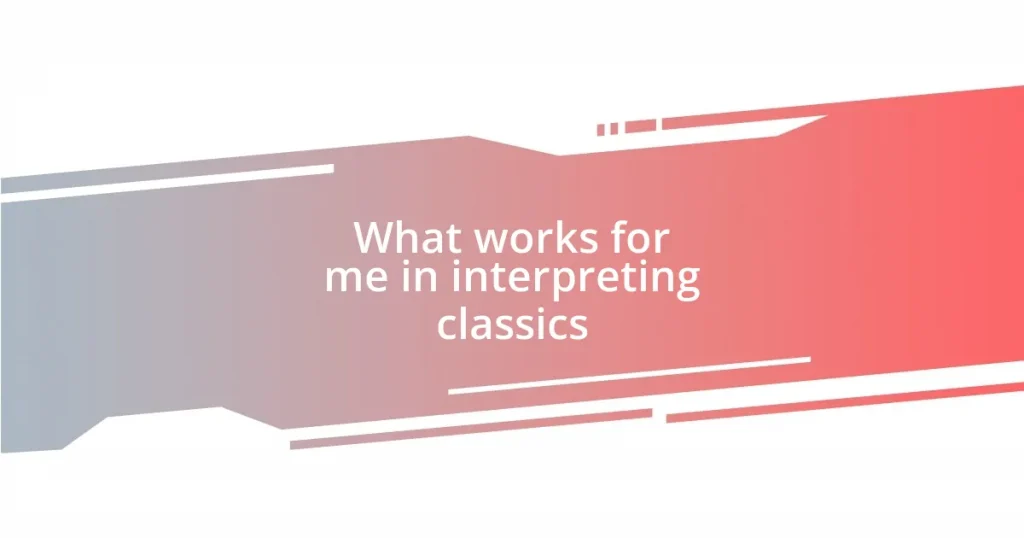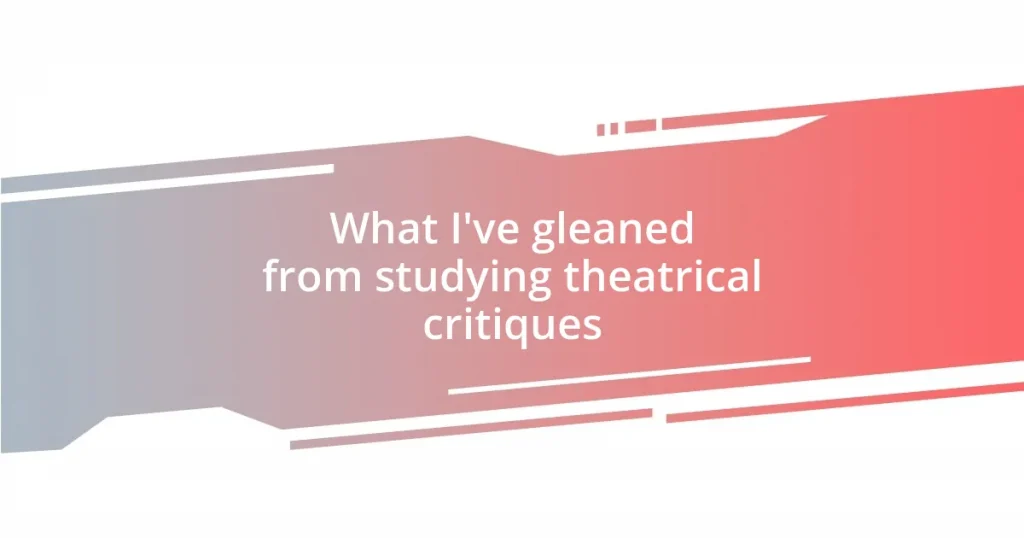Key takeaways:
- Character development reveals deeper layers of personality, impacting audience empathy and understanding of human behavior.
- Dialogue authenticity is crucial; capturing real speech patterns enhances character relatability and emotional connection.
- Effective script breakdown techniques, such as character mapping and scene analysis, facilitate a deeper understanding of narrative structure and themes.
- Script analysis enhances performance by uncovering subtext and character motivations, leading to more genuine portrayals on stage.
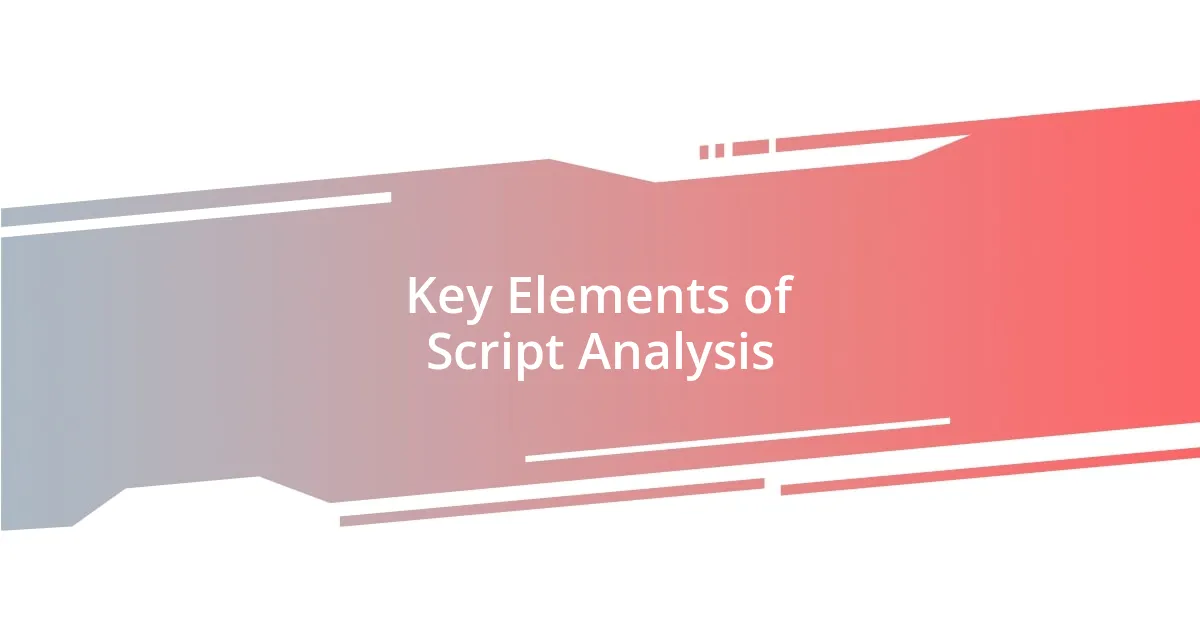
Key Elements of Script Analysis
When I dive into script analysis, one key element that always stands out is character development. I remember reading a script where the protagonist faced numerous moral dilemmas, and each choice revealed deeper layers of their personality. It made me question, could their transformation be my window into understanding complex human behavior?
Another essential aspect is dialogue. I’ve often found that the way characters communicate not only drives the plot but also reflects their inner struggles and relationships. For instance, a simple exchange between two friends can uncover hidden tensions or unspoken desires, prompting me to think, how do our own conversations shape our connections?
Lastly, I can’t ignore the significance of theme. Analyzing the underlying message of a script brings a profound emotional resonance. I recall studying a piece where the theme of redemption resonated with my own life experiences. It sparked a question: how do themes in narratives give us insights into our journeys? This exploration of themes transforms scripts from mere stories into personal reflections.
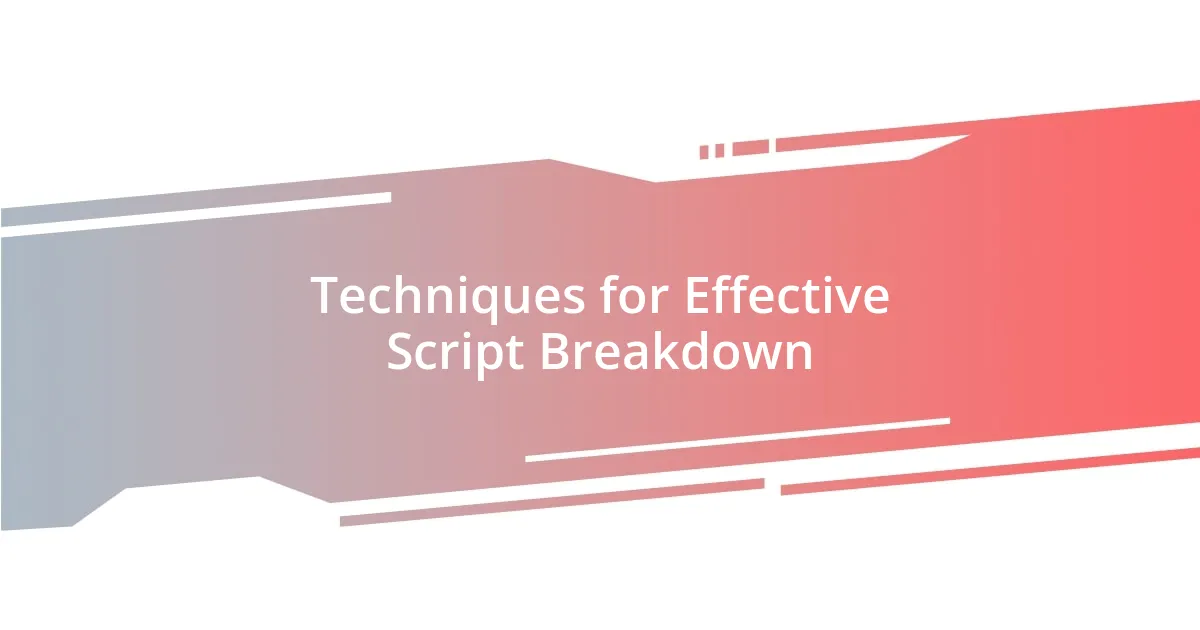
Techniques for Effective Script Breakdown
When I break down a script, I focus on a few specific techniques that really enhance my understanding. One method I find invaluable is using color-coded notes to highlight different aspects like character arcs, plot points, and themes. I recall working on a particularly complex screenplay where I used colored sticky notes for each character’s journey, and it was fascinating to see how their paths intertwined. This visual method not only helped map the narrative but also sparked conversations with fellow readers about the dynamics I might have initially overlooked.
Here are some techniques I use for script breakdown:
- Character Mapping: Create a visual representation of relationships and conflicts.
- Scene Analysis: Break down each scene to its core elements: purpose, emotional beats, and any underlying subtext.
- Thematic Tags: Tag scenes with themes to identify how they contribute to the overall message.
- Dialogue Notation: Make notes on how dialogue reveals character traits or advances the plot.
- Conflict Tracking: Keep a separate chart to track the various conflicts, ensuring a clear view of dramatic tension throughout the script.
By combining these techniques, I engage with the script on multiple levels, unfolding layers of meaning that might not be apparent at first glance.
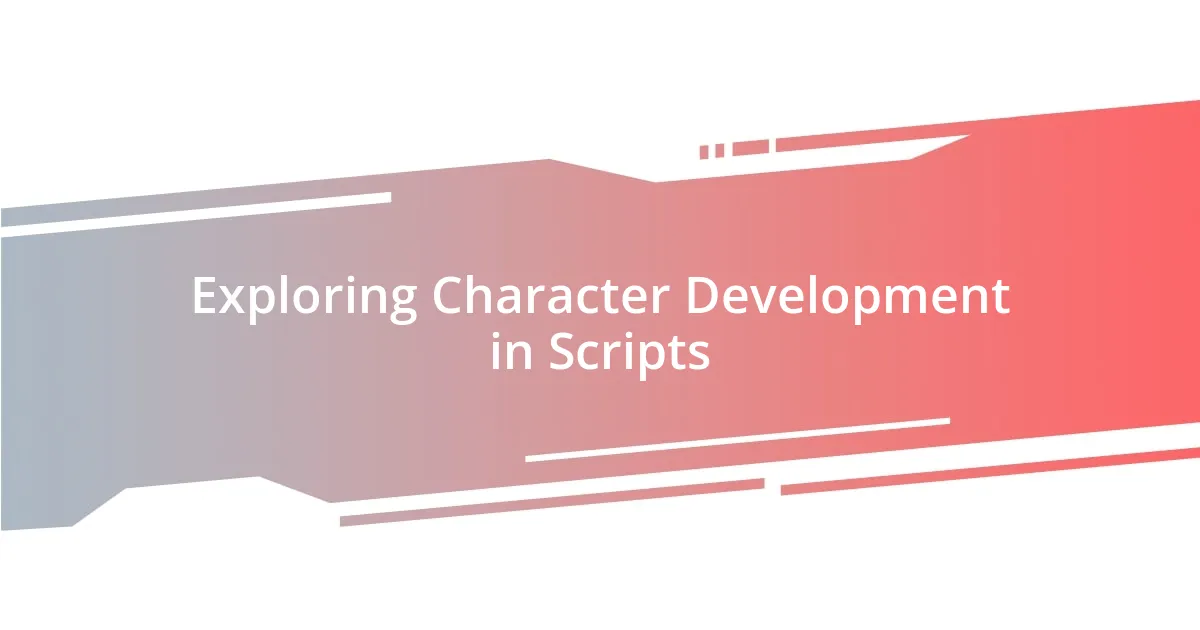
Exploring Character Development in Scripts
When I explore character development in scripts, I’m often captivated by the profound transformation journey that characters undertake. I remember watching a film where a seemingly unlikable character gradually revealed their insecurities and past traumas. This shift not only made me empathize with them but also opened my eyes to the complexities of human nature. Have you ever found yourself cheering for a character you initially disliked? It’s this depth of development that can leave a lasting impact.
There’s also an incredible value in observing the relationships between characters. In one script I analyzed, the evolving dynamic between two characters spoke volumes about trust and betrayal. Their interactions reflected not only their personal growth but also the broader themes of love and loss, challenging me to reflect on my own relationships. It’s enthralling how a well-crafted script can act like a mirror, revealing our motivations and fears through the lens of character connections.
Additionally, the pacing of character arcs is something I pay close attention to. I recall reading a novel adaptation where the protagonist’s growth felt rushed; it diminished the emotional weight of their journey. I found myself wondering, why does pacing matter so much in character development? It’s because each moment of hesitation, each small victory or setback contributes to a more authentic narrative. Understanding this allows me to appreciate the delicate balance between what drives a character forward and how real life unfolds at its own pace.
| Character Development Aspect | Description |
|---|---|
| Transformation Journey | Characters experience significant changes that often reveal deeper layers of personality. |
| Relationship Dynamics | Interaction between characters showcases personal growth and broader themes. |
| Pacing of Arcs | The timing of character development impacts the emotional weight of the narrative. |
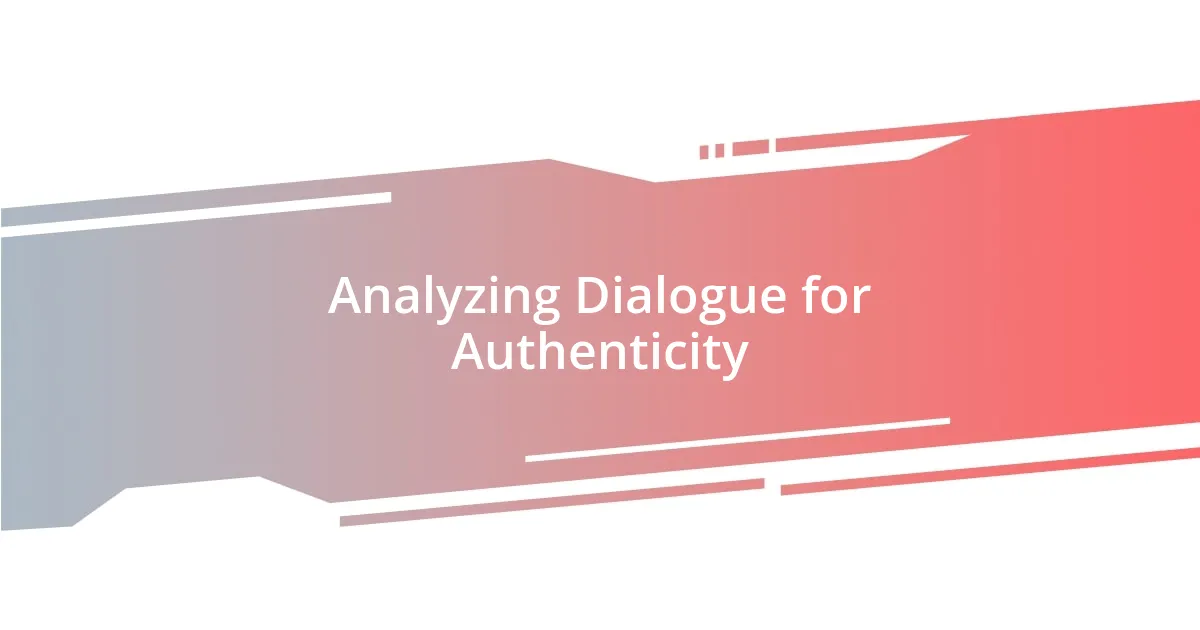
Analyzing Dialogue for Authenticity
Analyzing dialogue for authenticity is one of my favorite aspects of script analysis. I remember watching a film where a character’s dialogue felt so genuine that I could almost hear my friends speaking those same words. It made me reflect on how real conversations are often filled with hesitations, incomplete thoughts, and even contradictions. Have you ever noticed how people don’t always communicate perfectly? Capturing that essence in writing can make characters feel real and relatable.
I delve into the rhythm and tone of dialogue, assessing if it matches the characters’ backgrounds and perspectives. For instance, I once worked on a script featuring a highly educated protagonist who worked in academia but, in heated moments, slipped into colloquialisms. It was an intriguing choice that revealed layers of vulnerability and urgency. Such nuances in dialogue not only add depth but also allow audiences to connect emotionally with the character’s journey.
I also find that the use of subtext—the unspoken elements beneath the dialogue—can profoundly affect authenticity. There was a scene I analyzed where two characters spoke about mundane topics, while their facial expressions revealed a world of unacknowledged tension. It reminded me of how often I’ve had conversations that felt surface-level while harboring deeper emotions. Does this sound familiar to you? That’s the beauty of authentic dialogue; it mirrors life, revealing both what is said and what is left unsaid.
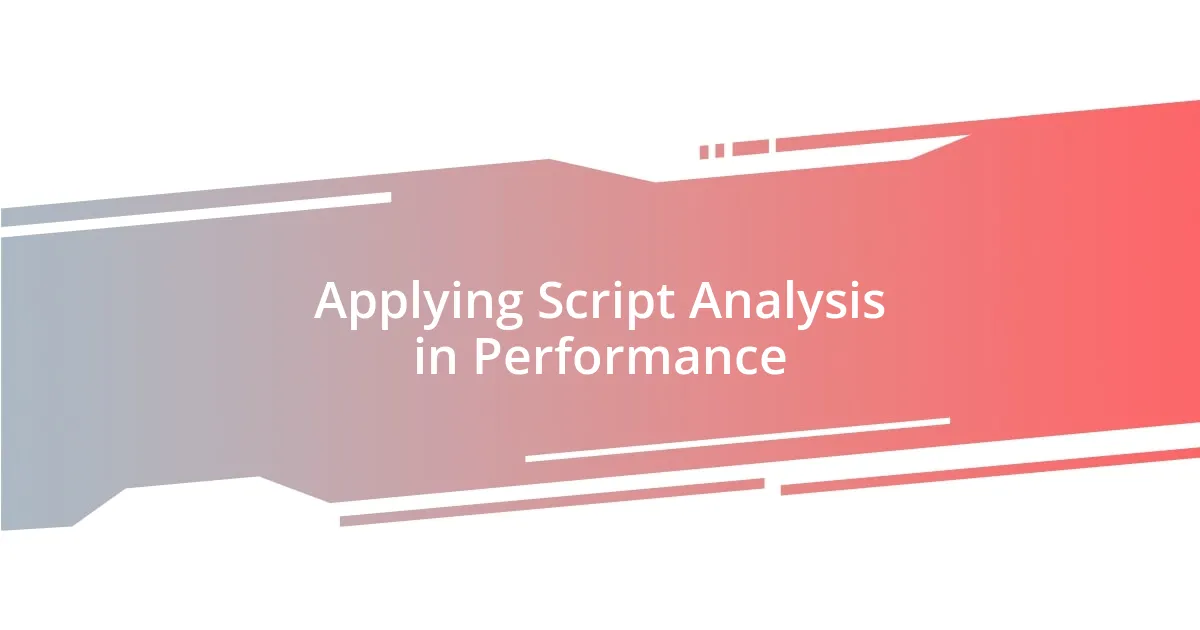
Applying Script Analysis in Performance
Incorporating script analysis into performance has dramatically changed how I approach acting. One time, I worked on a play with a subtle character whose internal struggles were only hinted at in the text. By digging deep into the script, I uncovered layers of vulnerability that I initially overlooked. This insight allowed me to authentically portray a character wrestling with fear and desire, ultimately transforming my performance.
I also find that collaborative discussions with fellow actors about script analysis can enhance our collective understanding of the material. During rehearsals for a scene filled with tension and conflict, I encouraged my co-star to explore subtext in our lines. By acknowledging what was unsaid, we uncovered a richness in our interactions, which not only made the scene more compelling but also brought us closer as performers. Have you ever experienced a moment where insight changed how you connected with another actor on stage?
Furthermore, I believe that script analysis plays a crucial role in interpreting a character’s motivations. When preparing for a particularly demanding role, I meticulously mapped out the character’s backstory based on hints within the script. This exercise deepened my connection to the character’s choices, allowing the audience to witness a journey that felt genuine and layered. It’s fascinating how understanding the minutiae can lead to impactful performances that resonate with viewers on an emotional level.














